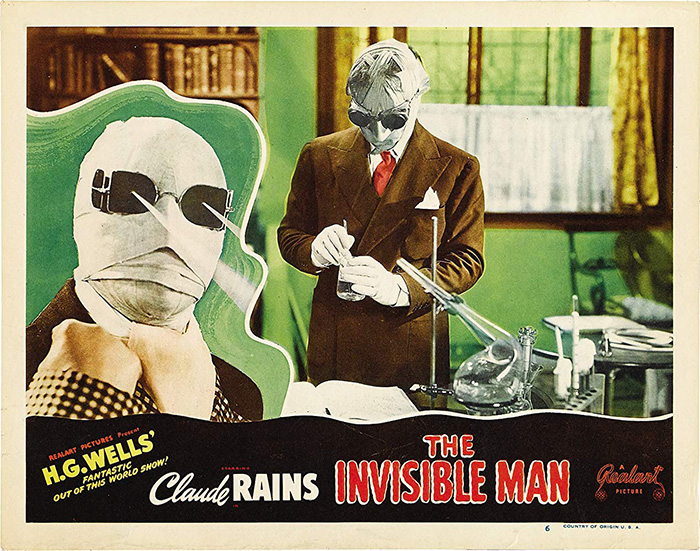There’s a way back, you fool!
I’ve never understood how people ask, “Which superpower is best?” as though there isn’t a definitive answer. Some will say flight. Some want x-ray vision. Some desire super-smarts or strength. But don’t all of those objectively pale in comparison to invisibility and the scope of what one can get away with if nobody can prove they were there? Its possibilities are both endless and endlessly terrifying—the latter a major reason why H.G. Wells‘ science fiction creation remains such a seminal figure within the horror genre. The power wielded by anonymity is enough to break even the most moral in society because a lack of accountability is a drug leading towards madness. Look at the millions of “invisible” trolls wreaking havoc online. Without consequences, restraint is rendered obsolete.
This truth is why we fear Dr. Jack Griffin. The more time he spends invisible, the more he realizes he answers to no one. What began as an intellectual hunger to find a cure soon transforms into a psychological hunger for survival. He steals to support his research and kills to stay alive. And once Griffin crosses those lines, he irrevocably changes his role within his own story. No longer a protagonist desperate to get better, he becomes a villain willing to do anything on his search for an advantage. It’s a scenario ripe for intrigue and social commentary because it gets at mankind’s baser desires. To therefore erase humanity as a core reason for Griffin’s monstrousness is to lose a bit of the narrative’s potency.

Is it surprising that Hollywood would do exactly this when adapting Wells’ book? Hardly. So while director James Whale‘s The Invisible Man retains a lot of the source material’s mood, R.C. Sherriff‘s script operates with a completely different motive. Rather than let Griffin (Claude Rains) devolve into a madman because of what he’s capable of doing without any risk of punishment, the movie introduces an external element that ensures his character remains sympathetic. The reason is simple: there’s a love interest in this version. We can’t invest in Flora’s (Gloria Stuart) hope for her beau’s return if he’s become an embodiment of the worst humanity has to offer. Sherriff is thus forced to create an internal Jekyll and Hyde war between Griffin the man and invisibility the monster.
Whether or not it’s a volatile chemical or hubris that’s ruined Griffin’s mind doesn’t actually matter, though, since the weight of this shoehorned romance will never equal that of the hysteria created by an invisible man running amok in civilized society. Flora’s creation is nothing more than a ploy to sell tickets (I can imagine the marketing meeting with old white men figuring out how to get women interested) and an excuse to somehow place some of the blame for his actions at her feet (Griffin says he did it for her because only fame and money would allow him to believe he deserved the love he already won). But while it provides yet another example of a patriarchal gaze, Wells’ source wrestles back control regardless.
We therefore forget all about her—an easy proposition considering the filmmakers didn’t give her purpose beyond that unnecessary sympathy anyway. Until her presence jogs Griffin’s memory of his former life (a feeling that passes quickly), he’s fully on the road to egomaniacal world domination. His frustration and failure to create a solution causes his rage to grow and blow up his spot (a bed above a sleepy town’s bar). Entitlement leads to retribution, privilege to coercion. If Griffin can recruit his former associate Dr. Kemp (William Harrigan) as the visible partner on his crusade to unchecked power, nothing will stop him. He gravely underestimates the fear he conjures, though. No matter what he promises, the reality that he could kill you in your sleep doesn’t fade away.

The Invisible Man picks up steam here as Griffin proves a major liability to anyone who once called him an ally (including Henry Travers as Flora’s father and his boss). Suspense can’t help but ratchet up. Kemp wants to save himself by calling the police, but he can’t know where his friend is to do so without recourse. The police want to figure out a foolproof plan to catch him, but they can’t know if he wasn’t in the room to hear it. Uncertainty looms above every frame of the film because we have to assume Griffin is present in each one. The silence can be broken by Rains’ crazed laughter or enraged confidence at any moment to reveal his character has been in control the whole time.
As a visual conceit, invisibility is a horror fan’s dream because special effects aren’t needed when a character’s absence is enough to have us bracing for impact. That doesn’t mean the effects aren’t memorable, though, with objects moving by wire and rudimentary “green screen” allowing Griffin to unmask while clothes yet to be removed keep his body’s shape intact. Nothing is scarier than that which we can’t see so a monster whose visage is literally air feeds into the trope of less is more perfectly. We watch men die (the body count is very high considering the comedic tone that often rises above the despair) without a chance of escape because they’re helpless to combat an enemy they don’t see coming—even though they know he is.

